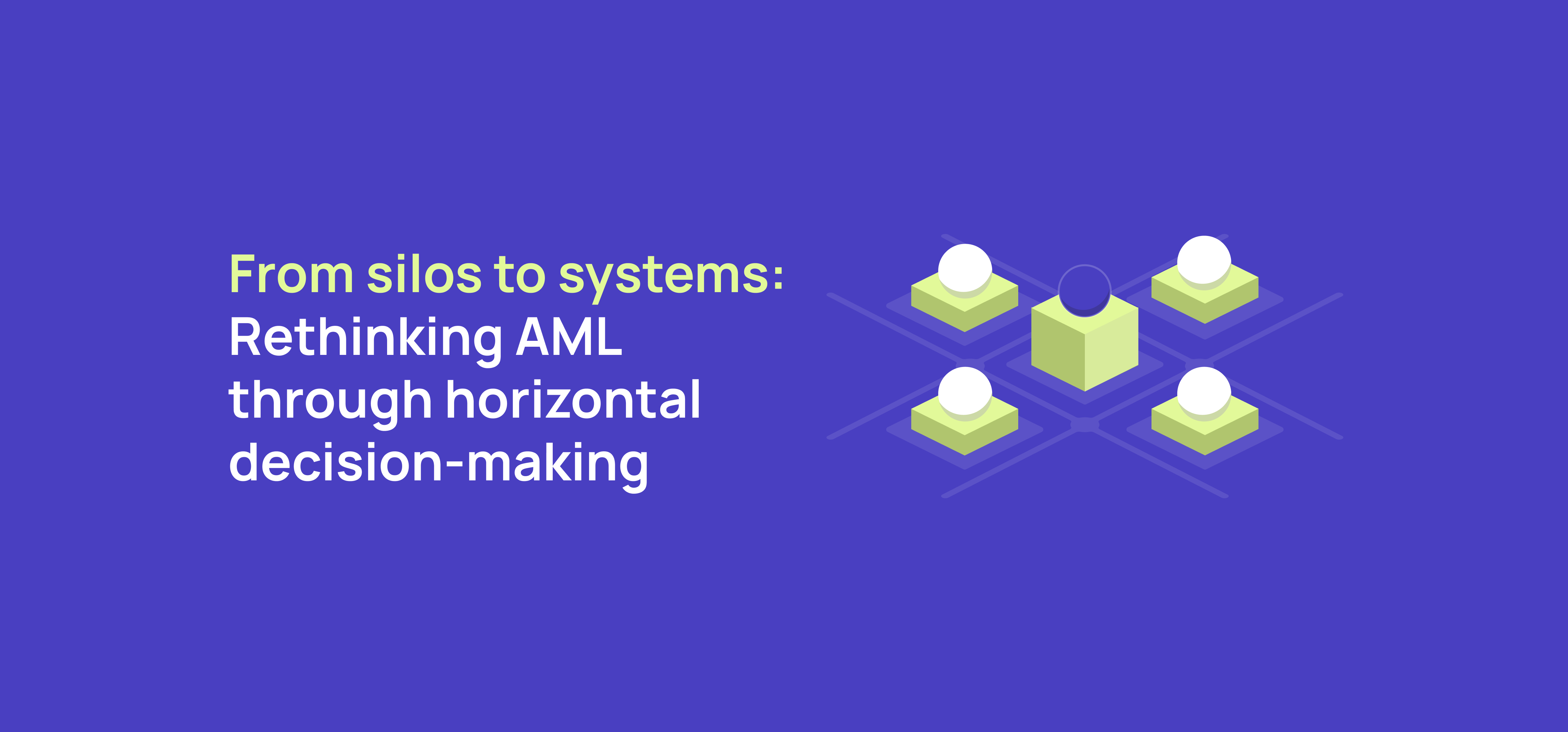AML 5 min read
From silos to systems: Rethinking AML through horizontal decision-making

For over half a century, anti-money laundering (AML) programs have evolved in response to one simple question: How do we stop bad actors from exploiting the financial system?
As noted in a McKinsey report, “The types of crimes and cyberattacks are converging, as attackers adapt to the digitization and automation of financial services. The transgressions are becoming more sophisticated, cutting across and effectively circumventing siloed responses. … The stakes in this fight have never been higher for financial institutions”.
Yet in chasing that goal, financial institutions have built increasingly complex architectures made up of dozens of specialized systems, each solving one slice of the problem.
This has left teams with a tangle of point solutions that often obscure the very insights they were designed to illuminate. Analysts drown in alerts, while fraudsters exploit the gaps between tools. Meanwhile, regulators demand more transparency and agility from systems that were never designed to talk to one another.
To meet the sophistication and speed of modern financial crime, the industry needs a new way of thinking—one that connects, rather than layers.
In this article, I break down the evolution of the AML landscape over the years and define effective systems going forward: those that look horizontally across the customer lifecycle instead of vertically within silos.
Key takeaways
- Architecture fragmentation: Decades of regulatory evolution have created a patchwork of specialized tools that solve isolated issues but fail to connect insights.
- Limits of bolt-on growth: Expanding legacy systems with adjacent features has only deepened fragmentation, latency, and operational blind spots.
- Horizontal model: Unifying decision logic across vendors and data sources enables real-time, lifecycle-aware financial crime prevention.
- Strategic shift: Forward-looking institutions are redefining AML as a connected, adaptive system—one built to outpace modern threats, not just report them.
The 50-year evolution of AML
The story of AML begins in 1970 with the Bank Secrecy Act (BSA), the first law requiring financial institutions to help detect and prevent money laundering. Its premise was straightforward: gather and share information to protect the integrity of the financial system.
Over the decades, new legislation and global initiatives built on that foundation, including the Money Laundering Control Act of 1986, the Patriot Act of 2001, successive EU AML Directives, and the FATF’s global recommendations. Each wave reflected the typologies of its time: structuring in the 1970s and ’80s, terrorist financing in the 2000s, and synthetic identities, and crypto laundering in the digital age.
With every new regulation came new technology—and new silos.
The era of point solutions: Solving one problem at a time
The industry’s first response was to solve one problem at a time. Transaction monitoring systems were built to detect structuring. Sanctions screening tools managed OFAC compliance. KYC systems verified customer identities.
This specialization created deep expertise but little connection. Each system excelled in its niche yet operated in isolation, blind to the signals from others. Compliance requirements, rather than strategic design, drove most technology decisions.
The result was a fragmented landscape: institutions collecting more data than ever but struggling to see the full picture of customer risk.
As BankingDive reports, institutions like N26 are actively modernizing their AML frameworks to strengthen resilience and transparency—part of a broader industry movement toward unified, data-connected systems.
This is not an isolated case: Leading digital banks are strengthening their AML capabilities to meet increasing regulatory expectations, investing in systems that deliver unified, end-to-end visibility across the customer lifecycle. The penalty, widely reported in 2025, underscores that even leading fintechs with rapid growth and advanced digital infrastructure are vulnerable to major regulatory action if their AML architectures fail to deliver end-to-end, unified oversight.
The bolt-on decades: Patchwork expansion and its limits
As typologies evolved, vendors tried to “grow horizontally,” bolting on adjacent capabilities to their core products. For example, transaction monitoring platforms added basic KYC checks, and screening tools introduced rudimentary risk scoring.
But patchwork growth had limits. Data moved slowly between systems. Alerts multiplied without context. Operational costs rose while transparency declined. And every new tool increased integration complexity and vendor lock-in.
Regulators, meanwhile, began asking harder questions about how firms connected their controls across the customer lifecycle—questions many couldn’t answer with confidence.
Why the status quo is unsustainable
In today’s AML landscape, financial crime no longer fits neatly into typology buckets. A synthetic identity used for onboarding might become a mule account tomorrow, layering transactions through cryptocurrency or instant payments. The risk is dynamic, interconnected, and fast-moving—while most AML infrastructures remain static and compartmentalized.
Institutions are expected to make real-time, cross-lifecycle risk decisions, yet their systems can’t keep pace. Adding a new rule or data source can take months. Analysts spend their days reconciling inconsistent outputs. The cost of compliance rises while the effectiveness of controls declines.
We’ve reached an inflection point—the problem can’t be fixed by adding more tools. It requires rethinking the architecture itself.
Implications for the future of AML
As the boundaries between fraud, AML, and compliance continue to blur, the industry’s mindset must shift from compliance management to financial crime prevention. A horizontally integrated approach enables institutions to:
- Detect complex, cross-channel typologies in real time.
- Design and test new strategies faster than emerging threats evolve.
- Future-proof compliance architectures against regulatory change.
This recommendation is echoed in recent academic research, which finds that ‘data unity is not merely an operational improvement but a foundational requirement for resilience, agility, and informed financial governance’ in modern financial institutions.
In this new paradigm, AML teams aren’t constrained by the limitations of their vendors—they are empowered by a platform that connects them. The business rationale for upgrading AML/CFT capabilities is well-acknowledged in major industry research. As the International Finance Corporation notes in its Good Practice Note for emerging market banks: “there is a ‘compelling business case to be made for upgrading a bank’s AML/CFT capabilities. Banks that lead the way in emerging markets are in stronger positions to maintain and/or grow their cross-border correspondent banking networks, strengthening their market presence and stability.’”
Taktile’s fundamentally different approach: A horizontal shift
At Taktile, we believe the future of AML lies in horizontal decision-making: an approach that connects every part of the financial crime program into one transparent, adaptive layer.
Rather than replacing specialized vendors, Taktile acts as the connective tissue between them. Institutions can orchestrate decisions across data sources, build and modify logic in real time—and maintain complete visibility into how every decision is made.
By design, this model turns AML from a collection of reactive systems into a unified, proactive strategy. Teams can deploy new typologies, integrate new data providers, and test hypotheses in days—not months—while maintaining auditability and control.
This is more than efficiency. It’s about regaining ownership of risk strategy and breaking free from the opacity and rigidity that have long defined legacy systems.
The end of AML fragmentation
Decision makers today are standing at a true inflection point in the history of financial crime prevention. For more than five decades, institutions have layered one point solution on top of another—building fragile, siloed architectures that were never designed to meet the complexity of modern AML challenges. But the landscape has changed.
The volume, velocity, and sophistication of bad actors are accelerating at a pace never seen before. Synthetic identities, mule networks, instant payments, crypto obfuscation, and AI-enabled fraud are converging into a tsunami of financial crime that is already straining legacy systems to their breaking point.
This moment demands more than incremental improvements. It requires bold leadership. Decision makers now face a pivotal choice: reimagine their AML infrastructure and embrace horizontal, transparent, and adaptive decision making—or risk being overwhelmed by the wave of emerging threats.
Those who seize this moment have the opportunity to turn the tide—to move beyond compliance checkboxes and build agile systems that can outpace bad actors. Those who do not will be left exposed, operating outdated architectures in a world that has already moved on.






